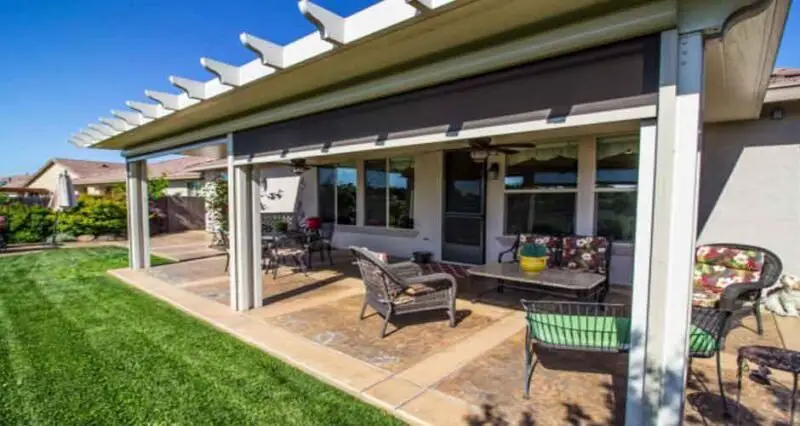
Patios have become increasingly popular in the U.S.; since 2020, over six in ten newly built homes have them. Before 2012, they were only in fewer than half of newly built houses.
That popularity is due to patios letting homeowners extend their living spaces to enjoy the outdoors. They also often cost less to install and are easier to maintain than decks.
An outdoor covered patio allows you to enjoy all those benefits while sheltering you from the elements.
To that end, we created this guide sharing tips on installing a covered patio. So read on, as what you learn here can help you choose a cover that best suits your home and backyard design.
1. Consider Your Patio’s Location
The location of patios determines whether they need attached or freestanding patio covers.
Consider getting an attached cover if your patio is only one or a few steps outside your house. You need a freestanding cover if it isn’t right next to your home (e.g., in the middle of the yard).
What Is an Attached Patio Cover?
An attached cover connects directly to the side of the house where the patio is. It provides a seamless transition from the indoors to the outdoors. So, as soon as you step outside, you can enjoy your outdoor space without worrying about the harsh UV rays or the rain.
What About a Freestanding Patio Cover?
A freestanding patio cover is a detached structure from your house. Posts provide it the support it needs to stand alone. There should be at least one post on each corner, but depending on the size of the structure, you may need more.
2. Explore the Perks of an Attached Patio Cover
Because an attached patio cover directly connects to one side of your house, you can expect it to be more stable.
Attached patio roofs can also help with thermal control. They shield the side of a house they attach to from the sun’s heat or chilly winds.
An attached outdoor patio cover can keep the inside of your home cooler during summer or warmer during winter. It also helps ease the workload of your HVAC system, contributing to lower heating and cooling bills.
3. Understand the Benefits of Freestanding Patio Covers
Since a freestanding patio cover doesn’t connect to any part of your home, it provides more flexibility in terms of placement. You can install one in the middle of your yard, on the other end of your property, or wherever you please. You can also design it as compact or large as you want, as you don’t have to factor in the space right next to your house.
Another perk of freestanding patio covers is their portability. Since they’re freestanding, you can move yours around or even take it to your new home if you decide to sell your existing one.
However, if you put your house up for sale, remember that a patio is one of the most sought-after and top-selling features of homes. So, you may want to consider selling it with the patio to attract more buyers.
4. Get to Know Popular Patio Cover Materials
Popular materials used in solid patio covers and louvered pergolas are aluminum, vinyl, and wood.
Aluminum is low-maintenance, lightweight, inexpensive, bug-resistant, and doesn’t rust. However, it can quickly develop dents due to impact.
Vinyl requires minimal maintenance, is termite-resistant, and, like aluminum, doesn’t rust and is inexpensive. However, it can still crack, fade, or deteriorate under constant exposure to the sun’s UV rays.
Wood costs more than aluminum and vinyl, but it’s biodegradable and more customizable. You can have it designed however you desire. It’s also the top choice for traditional, classic, or rustic homes.
5. Factor in Your Area’s Climate
The climate in your area is a crucial consideration when choosing a patio cover’s style and design. It can help you decide whether to get a solid roof, a louvered pergola, or an awning.
Let’s explore these popular styles further.
Solid Patio Covers
A solid patio cover is ideal if you live someplace where the sun can be relentless or heavy rainfalls and snow are the norm. It’s like a typical roof, providing complete shading from the sun, rain, and snow. With one of these on your patio, you can enjoy being outdoors without worrying about sunburns or getting drenched in the rain.
You can install a solid patio cover as an attached or freestanding structure.
Louvered Pergolas
A louvered pergola consists of louvers, which are adjustable slats you can tilt to control their openings. For example, you can open them during a pleasant day to let more sunlight and air in. You can then shut them once you’ve had enough sun or during a light rain.
Louvered pergolas offer some protection from the elements but don’t seal completely. So, they may not provide complete shelter during heavy rainfall.
Like solid patio covers, louvered pergolas can be freestanding or attached structures.
Patio Awnings
Patio awnings are solid covers made of acrylic, polyester, or vinyl affixed to the side of a home. They jut out at an angle and don’t require support posts. They can either be retractable (extendable and foldable) or fixed (permanently extended).
If you get a retractable patio awning, you can choose between a motorized and a manually operated one. Some motorized versions even work with sun and rain sensors. When the sensors detect sun and rain, they trigger the awning to extend.
While awnings protect against the sun and rain, their softer materials may be unable to withstand extreme rains and strong winds. So, if such events are typical where you live, you may be better off with solid patio covers. But if it has a mild climate and you’re on a budget, a patio awning can be an aesthetic and functional choice.
Follow These Tips When Installing an Outdoor Covered Patio
Remember: The outdoor covered patio you choose should depend on your patio’s location, the local climate, and your home’s design. By keeping these tips in mind, you can pick a cover that’s aesthetic, appropriate to your area’s weather conditions, and meets your budget.
For more practical home improvement tips like this, check out our recent blog posts!

